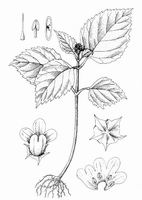
Ying T.S. et al., The endemic genera of seed plants in China, Fig. 114 (1993); with permission.
Full name and orig. publication: Gyrogyne W.T.Wang, Bull. Bot. Res. Harbin. 1: 41, 51 fig. 7 (1981), transl. & reimp. in Contr. New York Bot. Gard. 16: 21, 45, 55 fig. 6 (1986).
Etymology: From the Greek γυρος, gyros = round, and γυνη, gynē = female, wife, in botany pertaining to the female parts of the flower, in allusion to the (compressed-) globose ovary.
Infrafamilial position: Epithematoid Gesneriaceae (?).
Description: Perennial, terrestrial herbs, shortly rhizomatous. Stem caulescent, erect, with two or three nodes, unbranched. Leaves opposite, petiolate, slightly unequal in a pair, lamina ovate, margin coarsely serrate, pinnately veined. Cyme (pseudo-)terminal, stalked, few-flowered; bracteoles absent, flowers pedicellate. Sepals connate in lower half, plicate. Corolla white; tube short, broad, saccate at base; limb slightly shorter than tube, bilabiate, upper lip with two, lower lip with three rounded lobes. Nectary annular. Stamens 4, included, adnate to corolla base; filaments subulate; thecae divergent, nearly parallel, not confluent, connective projecting apically, dehiscence longicidal; staminode present. Ovary depressed globose, glabrous, unilocular, placentae parietal, ovary locule; style slender, c. 4x longer than ovary; stigma depressed globose. Fruit unknown.
Chromosome number: Unknown.
Type and only species: Gyrogyne subaequifolia W.T.Wang
Species names (incl. publication and synonyms): See Skog, L.E. & J.K. Boggan. 2005: World checklist of Gesneriaceae: http://persoon.si.edu/Gesneriaceae/Checklist.
Distribution: S China (W Guangxi).
Ecology: Growing on shaded waysides in hilly regions at low elevations.
Notes: By some floral characters (plicate calyx, broad-tubed corolla) the genus approaches Stauranthera; its weakly anisophyllous habit could be seen as an ancestral condition. However, there seem to be features, which make this placement and the inclusion in the Epithematoid Gesneriaceae doubtful: the indumentum (no hooked hairs!), and the structure of the ovary (one carpel sterile?). A placement in the Chirita- or Hemiboea-alliance (Didymocarpoid Gesneriaceae) appears possible. Due to lack of material, the genus could not be included in the molecular analysis of Epithematoid Gesneriaceae by Mayer et al. (2003).
Selected references: Wang et al. in Wu & Raven (eds.), Fl. China 18: 396 (1998); Mayer, Möller, Perret, Weber, Amer. J. Bot. 90(2): 321-329 (2003), molec. syst.
Bibliography: See Skog, L.E. & J.K. Boggan. 2005. Bibliography of the Gesneriaceae. 2nd edition: http://persoon.si.edu/Gesneriaceae/Bibliography.
Illustrations:
 |
Gyrogyne subaequifolium W.T. Wang, only
species
Ying T.S. et al., The endemic genera of seed plants in China, Fig. 114 (1993); with permission. |
last modified: 2007-07-13